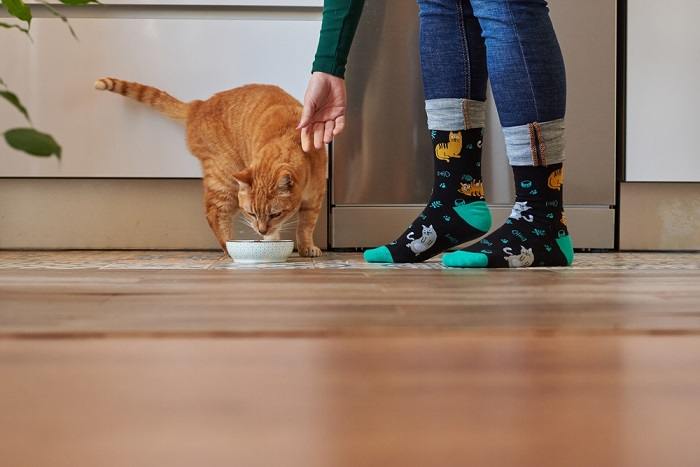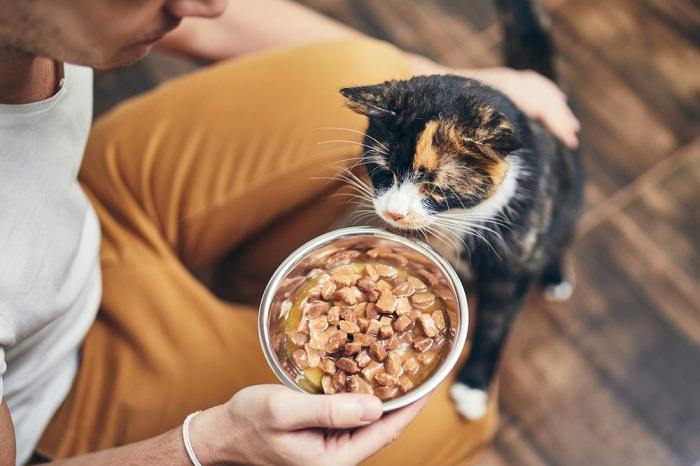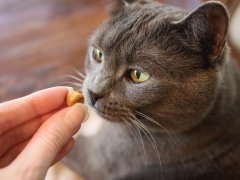
Affection eating, where your cat likes you to be near them (or even petting them) while they eat, is just one of many quirky habits found in the feline species.
This habit is thought to be an instinct left over from when our domestic cats’ wild ancestors would hunt alone but then eat in groups so they were less vulnerable to predators when their head was down, munching away. It can also be seen in kittens that are hand-fed by humans, and in anxious cats that just want some reassurance.
Some cats are affection eaters, wanting company during mealtimes. Affection eating might be due to cats' instinct to stay protected from predators while eating, be a habit if they were fed by humans as kittens, or because they don’t want to miss out on anything. Some cats are anxious and like extra reassurance, especially at mealtimes.Key Takeaways
Why Is My Cat An Affection Eater?
Affection eating can manifest in cats for a few different reasons, including:
1. Social Instinct
Cat behavior is a strange mix of solitary and social. Felines are generally territorial and hunt their prey alone rather than in groups. However, cats can form strong social bonds, live in groups, and participate in social activities such as grooming each other, sleeping together, and raising kittens together.
Wild cats also eat socially, bringing prey they have caught by themselves back into the group. Domestic cats have altered in many ways from their ancestors, and live in very different environments, but some wild instincts, such as convivial mealtimes, live on.
2. Safety
This group eating habit is partly a safety issue. Cats venture out into their wider peripheral territory areas to hunt and then retreat back to their inner core territory to eat. Having other cats around to watch out for predators means that your cat can relax and eat in peace. As a cat owner, you can fulfill this trustworthy function by being present while your cat munches away.
Anxious cats are more likely to be social eaters, even if they usually hide away from contact. A good way to encourage a timid, fearful, or stressed cat to eat is to sit with them, speak to them gently, and even stroke them.
3. Ingrained Habits

If a cat grew up with an involved caregiver who was actively involved in mealtimes, they might be used to this routine.
Cats are very much creatures of routine, and what they learn as young kittens is likely to stick. Many owners with tiny kittens will lavish care on them: helping them to eat, even via syringe feeds or being spoon-fed, sitting with them to make sure all of the littermates get their turn at the bowl, helping mum to clean them up, and generally enjoying petting the little bundles of fur.
These kittens will grow up into adult cats, and might have a lasting memory that eating food involves affection, care, and the presence of a trusted caregiver. Some habits are hard to break!
4. Being Involved, Feeling Connected
Cats are known for their curiosity, and often like to be in the center of the action, even if just as an observer. Your cat might like you there with them as they eat so that their meal is the main focus of the household, and they can be confident that you’re not off having fun while they’re eating! Cats often have a strong bond with their human caregivers and like to share key experiences with them, such as mealtimes.
Can Affection Eating Be Bad For Cats?
Anorexia (not eating) in cats can indeed be dangerous. If cats don’t eat for a few days, they can develop a condition called fatty liver (hepatic lipidosis), where fat is stored in the liver as the body enters starvation mode. Cats’ livers cannot process fat very efficiently, and as the fat builds up it causes progressive inflammation and the liver starts to slow down and work inefficiently.
Fatty liver can be a very serious disease and is often fatal without prompt veterinary treatment. Symptoms include weight loss, vomiting bile, diarrhea, jaundice, lethargy, and drooling.
Affectionate eaters prefer to eat with company, but it is unusual for this condition to cause a complete loss of appetite. However, exacerbating factors, such as a sudden change of diet, or any stressors, such as moving to a new environment, the introduction of a new pet, or new additions to the household such as human babies can all lead to a reduced and even absent appetite in cats.
However, it is very possible that a medical issue is causing your cat’s poor appetite. Many health conditions in cats can lead to inappetence, including gastrointestinal problems, kidney disease, and diabetes.
Any lack of appetite should be investigated promptly. If your cat won’t eat on its own but will eat a little of its own food with you present, a veterinary appointment is still recommended as anorexia can have such severe consequences in cats.
If you are worried about your cat’s diet, appetite, or food intake, always contact a veterinarian.
How To Manage A Social Eater: Practical Tips

Feeding your cat in a different part of the house might help them feel more comfortable about eating alone.
Owning a pet that will only eat if you are present sounds quite sweet, but the practicalities can be a little tricky, especially in our modern, busy lives. Here are some tips as to how to manage this condition in everyday life by making small changes to your cat’s environment:
- Move your cat’s food bowl to an area where they will eat alone. Ideally, this is a quiet place with a good view of busier parts of the house, so your cat can eat in peace and yet still feel part of the action. Some cats like their food bowls in a high-traffic area, while others prefer a bit of peace, so this might take some trials to get right for your individual pet.
- Position the cat’s food bowl away from water bowls. Cats in the wild won’t drink water that is near food sources due to risk of contamination. Bowls should also be away from walls so your cat doesn’t have to turn their back on potential threats to eat.
- Try elevated food bowls, so has a good view of their surrounding environment.
- Add a second food bowl, to give your cat more options to eat when a pet or human companion is present or nearby.
- Keep food hygiene optimal. Some cats are fussier than others about the freshness of the food and the cleanliness of the bowl.
- Give your cat plenty of time and attention away from mealtimes with grooming, playtime, cuddling, and lap time. Spending time with your cat will help them feel reassured and safe in their home.
- If you must leave your pet for a vacation, get them used to their care situation before you leave. This might involve introducing them to new human friends, or using an automatic feeder for a while before you go. Using a tasty treat or two might help ease any transitions.
- Practice patience. It might take a while to transition your cat away from social eating.
Some cats are known as affection eaters because they enjoy company at mealtimes. This quirky habit is more often a trait of anxious cats that want that extra reassurance that comes with a trusted presence at mealtimes, but some cats are just in the habit of having company at the food bowl.
This trait can be difficult to manage in a practical sense, but there are some steps you can take to ease your cat toward independent eating. A lack of appetite can cause serious health concerns in cats, so seek veterinary advice if your cat is not eating well.
Also Read: Why Does My Cat Beg For Food?
Frequently Asked Questions
Why won’t my cat eat unless I watch him?
Some cats are affectionate eaters, wanting company as they eat. This is usually due to an instinctive need to be protected whilst they concentrate on their food but can be a habit from kittenhood or a desire not to be left out.
Why does my cat only eat when I watch her?
Affection eaters like company when they eat. This is thought to be due to their instinct to eat in groups, to stay protected from predators while concentrating on their meal. It could also be a habit if they were fed by a human as a young kitten, or because they don’t want to miss out on anything.
Why does my cat not like to eat alone?
Cats are often solitary hunters but social eaters, bringing food back to their social group to eat. This is thought to be a protective response so that they are less vulnerable as they focus on their meal. Some cats are anxious and like extra reassurance, especially at mealtimes.







